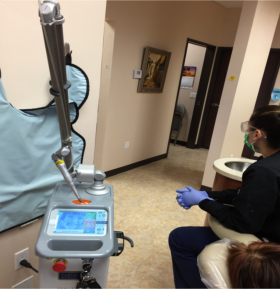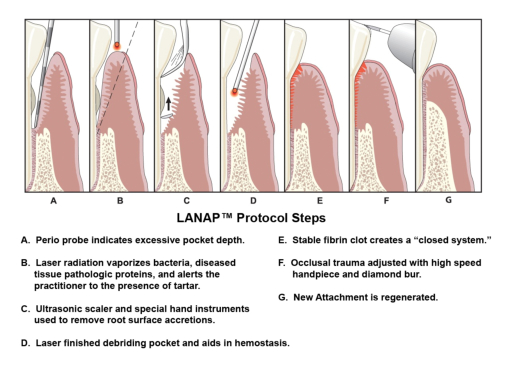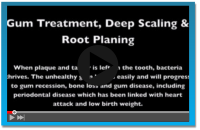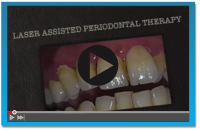Laser Therapy
What is Laser Periodontal Therapy™?
Laser Periodontal Therapy™ also Known as LANAP is a laser-based technique for the treatment of periodontal disease using the PerioLase Laser. Laser
 Periodontal Therapy is an amazing breakthrough in the treatment of periodontal disease. If you have been told that you need gum surgery or you have periodontal disease, this new technology replaces cutting the gum tissue with a scalpel and does not require stitches. This means an easier recovery with minimal bleeding, which preserves gum tissue and reduces root exposure and sensitivity.
Periodontal Therapy is an amazing breakthrough in the treatment of periodontal disease. If you have been told that you need gum surgery or you have periodontal disease, this new technology replaces cutting the gum tissue with a scalpel and does not require stitches. This means an easier recovery with minimal bleeding, which preserves gum tissue and reduces root exposure and sensitivity.
What is gum disease?
It’s an infection of the gums. It starts out as plaque, a sticky film on the teeth that hardens to form calculus or tartar. As tartar accumulates, it harbors bacteria which attack the soft tissue around the gums. This early stage of gum disease is called Gingivitis. Symptoms include red swollen gums, bleeding, bad breath, and sometimes an unpleasant taste in the mouth. Left untreated, Gingivitis becomes Periodontitis. At this severe stage, bacteria destroy both the gums and the supporting bone structure. Pockets form where the gums separate from the teeth and surrounding bone. Left untreated, Periodontitis often results in tooth loss. There is scientific evidence of a direct link between gum disease and a variety of other major health issues such as heart attacks, strokes, miscarriages and diabetes. How does a laser treat gum disease? The way to repair the damage from gum disease is to get rid of the infection and close up the infected pockets between the gum and teeth. LANAP is a minimally-invasive alternative to traditional gum surgery. It uses a digital dental laser – the PerioLase MVP-7, to remove harmful bacteria and diseased tissue from the gum pocket by passing a laser light between the gum and tooth. First, we use a local anesthetic to eliminate any possible discomfort. A tiny laser fiber (about the thickness of three human hairs) is inserted between the tooth and gum and the infection is cleared away by removing only the diseased tissue. Next, we use an ultrasonic scaler and small instruments to remove the tartar from the root surface of the tooth. Then, laser light energy is again directed between the gum and tooth. The laser helps reduce the bacteria and stimulates your body’s existing cells to grow new root surface coating and new connective tissue attachment to the root surface. All of this is done without making any type of incision. After removing the diseased tissue, the laser immediately cauterizes the wound. The result is that you experience little to no bleeding. An added benefit of the laser is its ability to seal the nerve endings. The entire process results in only minor discomfort afterward.
How does a laser treat gum disease?
The way to repair the damage from gum disease is to get rid of the infection and close up the infected pockets between the gum and teeth. LANAP is a minimally-invasive alternative to traditional gum surgery. It uses a digital dental laser – the PerioLase MVP-7, to remove harmful bacteria and diseased tissue from the gum pocket by passing a laser light between the gum and tooth. First, we use a local anesthetic to eliminate any possible discomfort. A tiny laser fiber (about the thickness of three human hairs) is inserted between the tooth and gum and the infection is cleared away by removing only the diseased tissue. Next, we use an ultrasonic scaler and small instruments to remove the tartar from the root surface of the tooth. Then, laser light energy is again directed between the gum and tooth. The laser helps reduce the bacteria and stimulates your body’s existing cells to grow new root surface coating and new connective tissue attachment to the root surface. All of this is done without making any type of incision. After removing the diseased tissue, the laser immediately cauterizes the wound. The result is that you experience little to no bleeding. An added benefit of the laser is its ability to seal the nerve endings. The entire process results in only minor discomfort afterward.
Laser therapy benefits
The laser is an effective tool for improving overall dental health with less pain, less bleeding, less swelling, less tissue removal, and less recovery time than traditional gum surgery or periodontal treatment. It provides a viable alternative to traditional gum surgery that is less invasive and more appealing to some patients who may otherwise avoid necessary treatment due to fear or prolonged treatment time. Some of the benefits include: • Less traumatic yet highly effective alternative to traditional gum surgery. • Less discomfort than with standard surgery, both during and after the procedure. • Less time than traditional surgery. • Lasting results, with 98% of LPT treated patients remaining stable after five years. • Less recovery time in that there is less than a 24-hour recovery period. • Safe for patients with health concerns such as diabetes, hemophilia, HIV, or those taking medications such as Coumadin or Cyclosporin.
How is the therapy performed?

Frequently Asked Questions
Does Laser Periodontal Therapy hurt?
The procedure itself is virtually painless; however, we anesthetize the area for your comfort. In this way we can precisely direct the laser for treatment. Post-procedure discomfort is typically minimal and of short duration.
How long does it take?
Depending on the severity of the patient’s periodontal disease, treatment may be accomplished in one office visit or in multiple visits. We will review the estimated treatment time when we discuss your treatment plan.
What about recovery – will I be in pain or need to follow a special routine?
The sense of recovery is immediate, due to the laser’s ability to seal blood vessels, lymphatic'sand nerve endings. Of course, your tissue needs time to recover, regenerate and heal over the course of time, but after Laser Periodontal Therapy, you can drive your car, go back to work, or do anything else you like. During the initial healing phase, we ask that you only eat a soft diet and that you use a mouth rinse for oral hygiene, all of which will be explained in detail during your consultation.
Does this treatment cost more than traditional gum surgery?
Typically we use the same billing codes as traditional gum surgery and the laser treatment is generally no more expensive than the traditional surgery. There are other factors which may affect the cost, such as the severity of the periodontal disease and how many teeth are involved. Many insurance plans pay only for a portion of this treatment. Patients should discuss their payment options with our patient treatment coordinator, as we offer financing for this treatment if needed.
Instructions After Laser Therapy
Patients heal faster from laser therapy than from traditional surgery partly because of the protective blood clot that forms between the gum and tooth at the treatment site. It is extremely important not to dislodge those tiny clots that form in and around the gums. Following these instructions will protect the gums and keep your healing on track:
Activity
Reduce physical activity for several hours following surgery.
Do not apply excessive tongue or cheek pressure to the treated area.
Hygiene
Do not brush or floss your teeth until instructed to do so, usually 10 days after laser therapy.
It is ok to spit, rinse and wash your mouth the day of laser therapy. Rinse as directed with Peridex or Periogard morning and night. You can rinse gently every three hours with warm salt water (1/2 teaspoon of salt dissolved in an 8-ounce glass of warm water).
Keep your mouth as clean as possible order to help the healing process. Brush, floss and follow other home-care instructions in all areas of your mouth except for the area treated with the laser.
Take any antimicrobial rinses, or antibiotic medications according to the directions, and until all meds are gone.
Diet
Stay on a liquid diet for the first two days after laser treatment. Do not drink through a straw since this creates a vacuum that can disturb the clot.
For the following 3-7 days after surgery, we recommend a very soft diet. Try eggs, yogurt, cheese, malts, ice cream, oatmeal, mashed potatoes, applesauce or blended fruit (except berries with seeds), broth or creamed soup, mashed steamed vegetables, creamy peanut butter, cottage cheese, gelatin, pudding, nutrition drinks, milk shakes and smoothies. It is also important to maintain fluid intake.
Days 7-10, soft foods like pasta, fish, chicken or steamed vegetables are allowed. Gradually add back your regular diet. Remember that even 10 days after treatment, healing is not complete. Softer foods are best for the first month after laser treatment. Stay away from spicy and hard foods like chips, gum, candy, cookies, nuts or anything hard or crunchy, anything with seeds or hard pieces, meat that shreds and can lodge under the gum or between teeth, and raw vegetables or salads.
Changes in your gums
Do not be alarmed about any color changes or the appearance of gum tissues following laser therapy. Tissues can be gray, yellow, red, blue, purple, or stringy-looking. That reflects normal response to laser treatment.
Beginning just two weeks after laser therapy and for as long a year, the teeth may become sore, tender or sensitive as the bone and ligaments around the teeth regenerate and become more firm.
This is a sign of healing, but may also indicate the presence of a bite imbalance that may need to be adjusted.
Do not be alarmed if one of the following occurs:
• Light bleeding• Slight swelling
• Some soreness, tenderness or tooth sensitivity
• Medicinal taste from Peridex or Periogard
Smoking
If you smoke, we encourage you to stop or talk to Dr. Gao about smoking cessation methods. If you continue to smoke, we recommend that you abstain or significantly reduce your smoking for 1-2 weeks before and after treatment, since smoking may affect healing and the outcome of the procedure.Call Us
Please call the office if you experience any of these signs:
- Prolonged or severe pain
- Prolonged or excessive bleeding
- Considerable elevated or persistent temperature.
For more information, click on the videos below:
 |
 |
 |
 |
